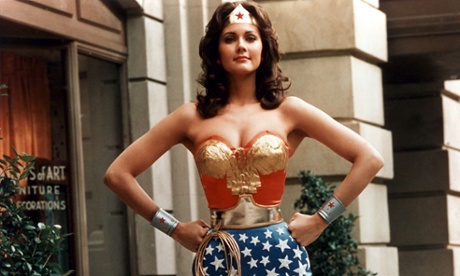
Wonder Woman is a sex symbol. There’s not really any way around it. She wears a revealing swimsuit, her weapons – bracelets, a lasso – reference bondage gear, and Lynda Carter was an unbashed pin-up.
Wonder Woman has passed that erotic legacy down to her superhero daughters. Superhero women from Phantom Lady in the 1940s (infamously drawn by Matt Baker) to Spider-Woman (in this equally infamous 2014 image by Milo Manera) have flirted, or more than flirted, with softcore porn. Every so often men’s magazines will take the explicit implications and run with them (such as the Wonder Woman shoot Playboy Mexico did with telenovela star Gaby Ramírez).
As more women have become fans of superheroes in recent years, this sexualization has come in for criticism. Jill Lepore, author of The Secret History of Wonder Woman, repeats some of the objections in a recent review of the new all-female Avengers title A-Force. Lepore looks at the A-Force cover, stuffed to the brim with superheroes from She-Hulk to Dazzler, and notices a certain similarity. “They all look like porn stars,” she complains.
As G Willow Wilson, the writer on A-Force, told Lepore, they don’t actually look like porn stars, unless the porn you’re watching features “full-coverage gymnastics leotards”. Still, Lepore is correct that the range of body types on display is limited to the standard slim/attractive/bosomy default, and that many of the costumes are highly sexualized.
Lepore links this back to Wonder Woman creator William Marston’s own fascination with pin-ups and erotica. She notes that Marston – a psychologist, an academic, and something of a carny – actually wrote copy for a pin-up magazine at one point (though she doesn’t mention that he also wrote a softcore porn novel about Julius Caesar). “Maybe it’s not possible to create reasonable female comic-book superheroes, since their origins are so tangled up with magazines for men,” Lepore speculates. For Lepore, sex makes female superheroes ridiculous. Presented with erotic content, she turns up her nose and says, with her 10-year-old companion sneering at the Hulk/Black Widow romance in Age of Ultron: “Bleurgh.”
Wonder Woman’s creator, though, had a different take. As Lepore notes, Marston, his wife Elizabeth, and their polyamorous lover Olive Byrne, wrote a letter together in which they explained: “This family believes [pornographic magazines] furnish splendid material with which to teach children that the most lovely and sacred thing in the world is a real woman’s body.” Marston believed that looking at women’s bodies was a healthy, pleasurable and even sacred activity – and not just for men. In that softcore Julius Caesar novel, Marston referred to lesbian love as “perfect” – in his scholarly books he argued that women who slept with other women were superior lovers and mothers. Marston lived in a polyamorous relationship with two almost certainly bisexual women. Eroticized images of women, for him, were never just for men.
Lepore sees eroticized images as ridiculous, unpleasant and opposed to women’s interests. For Marston, though, the problem with comics was not eroticism but “blood-curdling masculinity”. Sex, for Marston, was great; the downside of superhero comics, though, was that they featured lots of men hitting each other.
Wonder Woman was meant, deliberately, to undermine both the masculinity and the violence. Her magic lasso was later downgraded to a lasso of truth, but originally it was a lasso of control – whoever was bound by it had to do what the wielder said. The original Wonder Woman comics (drawn by artist Harry Peter) mostly eschewed fisticuffs; instead, they featured vertiginous bondage romps, in which Wonder Woman tied people up, and then got tied up in turn, and then tied those other folks up again. The lasso itself, Marston explained, was a “symbol of female charm, allure, oomph, attraction” and of the influence that “every woman has … over people of both sexes”. Since the lasso is also a fairly glaring yonic symbol, the message is clear; Wonder Woman battles evil not with violence, but with erotics. She is, literally, super sexy.
This isn’t to say that any and all eroticism in superhero comics is awesome. The one-size-fits-all body type can be wearisome, and as Janelle Asselin pointed out, giving your teen heroines massive implants is a bad idea for all sorts of reasons. Nor does a comic have to choose, necessarily, between sex and violence. Willow Wilson’s wonderful Ms Marvel comic features a young Muslim heroine in low-key adventures. The 17-year-old protagonist is not sexualized, and she’s not very violent either – she is upset when she has to kill a giant mutant alligator, and seriously disturbed when she hits a villain and knocks her unconscious. The story is driven, not by sex or violence, but by characterization – plus cameos from a giant teleporting dog. My 11-year-old son loves it.
But my son loves the original Wonder Woman comics too – bondage games, sexy swimsuit and all. Lepore seems to think that sex and heroism can’t go together; that if women are presented as erotic or attractive, then their heroism is automatically undermined. Allure is not power, Lepore insists, but “the absence of power”. When superheroines are sexy, she says, “their bodies are not their own. They are without force.” But that default assumes that the only kind of force that matters is violence, and that sex or love are automatically less valid, less interesting and less ennobling than hitting people. Superhero stories often present that as truth – but, as you’d think Lepore would know, Wonder Woman had a different vision.

